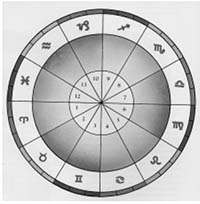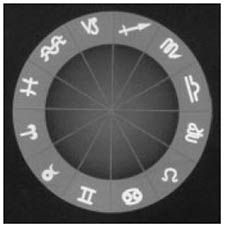Zodiac
| By: Carl Teichrib; ©2002 |
| In this last installment of his series on occult symbols, Carl Teichrib explains the connection between the occult philosophies of “deity” and the Zodiac’s greater religious significance. |
- Once a sign, a symbol, has had a specific meaning, especially of a complex subject attributed to it, it then serves a most practical purpose. It can become universal, that is, often having the same meaning regardless of differences in language. —Ralph M. Lewis, “Psychology of Symbolism,” Rosicrucian Digest, March 1981, p. 4.
- Symbolical instruction is recommended by the constant and uniform usage of antiquity; and it has retained its influence throughout all ages, as a system of mysterious communication. —Albert Pike, Morals and Dogma, p. 372.
This article marks the twentieth and last in an ongoing series on occult symbols.
Erwin Watermeyer, an initiated Rosicrucian, explained in an article published in the Rosicrucian Digest, that “throughout his studies the student of mysticism meets manifold symbols. They face him from books and from temple walls….”
Students of the occult are not the only ones who see “manifold symbols.” Throughout North America, and all over the world, esoteric symbols are prominently displayed on temples, public buildings, statues and monuments, shields and crests, banners and flags, and even on currencies. Inevitably, each one of us will encounter occult symbols sometime, somewhere. Many of us see mystical symbols on a daily basis as we travel or conduct business. In the United States, the Great Seal on the back of the one dollar bill is a prime example of a “daily” esoteric symbol (Joseph Campbell’s book The Power of Myth has a fairly good explanation of the Great Seal’s significance).
Mystical symbols act as an authentic language system to those who understand its speech. Moreover, the symbols in our discussion contain spiritual dimensions, wrapped in centuries of mysticism and occultism; this is not about simple road signs and traffic markers. Sadly, occult symbols—“road markers” which point the way to “alternative doctrines” — have been openly propagated by the rapid advancement of the New Age Movement. Today’s neo-pagan world is awash in this ancient esoteric language.
Steeped in the philosophies of pagan mystery religions and secret societies, this occult foundation forms a spiritual alternative to the Biblical worldview; fully equipped with alternative histories, alternative ways of salvation, alternative gods, and alternative realities—the truth of God has been traded for a lie.
Understanding this new spiritual reality greatly amplifies the words of Proverbs 14:12, “There is a way that seems right to a man, but in the end it leads to death.”
Manly P. Hall, one of the most influential occultists of the last century, wrote this of symbols, “They are centers of a mighty force, figures pregnant with an awful power…” (Lectures on Ancient Philosophy, p. 356).
Contents
Zodiac:
Explaining and documenting the meaning of the Zodiac and its various symbols could easily become a book in itself. At first glance the Zodiac seems simplistic in the sense that our newspapers and tabloids give daily universal horoscope readings for mass consumption—these “readings” inevitably are general in nature and often times seem juvenile. However, examining the historical and cultural significance of the Zodiac, along with its enormous mythological scope and its various meanings, rapidly becomes a time consuming and complex endeavor. It’s not as simplistic as it seems.
Jean Chevalier and Alain Gheerbrant, authors of The Penguin Dictionary of Symbols, succinctly explains this complexity,
- The Zodiac is simultaneously a symbol in its own right and a collection of individual symbols of which the significance varies with the charges in their interrelationship. Then, too, [it] has both the most highly concentrated and the most widely diffused meaning (Penguin Dictionary of Symbols, p. 1146).
Understanding that the subject matter is extensive, it must be stated upfront that this article hardly begins to scratch the surface. Individual signs and symbols within the Zodiac will not be examined; rather, what will be looked at is the connection between the occult philosophies of “deity” and the Zodiac’s greater religious significance. Hopefully, this final article in the occult symbols series will aid you in understanding the spiritual deceptions of our world. In so doing, it is wise to remember the words of Ephesians 6, “For we do not wrestle against flesh and blood, but against principalities, against powers, against the rulers of the darkness of this age, against spiritual hosts of wickedness in the heavenly places.”

The Zodiac as an esoteric concept is heavily employed in occult societies and secret mystery religions. The Hermetic Order of the Golden Dawn, a society of “practical magic,” completely integrates the Zodiac into its teachings and ceremonies—including its Pentagram rituals. Furthermore, the Golden Dawn links the Zodiac with that of planetary and Solar spirits, and the occult-spiritual powers of elemental properties such as earth, fire, air, and water. However, the Golden Dawn isn’t unique to this infusion of astrological doctrines.
While the role of the Zodiac is debated in the workings of Freemasonry, there are some interesting thoughts and links on the subject. Albert Pike—the one individual most responsible for restructuring the Masonic Scottish Rite—explained that the Zodiac has influenced the Royal Arch Degree (Morals and Dogma, p. 409). Moreover, Masonic philosopher A. E. Waite also recognized an astrological overtone within the Lodge (A New Encyclopedia of Freemasonry). True, these are fascinating links, but they’re not necessarily conclusive.
However, what is revealing, especially in Pike’s writings, is the development of astrological pagan history and doctrines—which are valuable in understanding the Zodiac’s general occult roots.
In Morals and Dogma, Pike wrote that the “ancient astrologers divided the twelve signs of the Zodiac into six male and six female, and assigned them to six male and six female Great Gods” (p. 658). Thus, the Zodiac became a representation of the dualistic nature of the cosmic life-force (see article 19 in this series for more information on dualism). Pike also detailed an occult doctrine that bridges the Zodiac with that of the “universal soul” —a teaching which states that a divine intelligence infuses all of creation. Elaborating on this doctrine, Pike explained, “Wherever the divine soul acted as a cause, there also was intelligence; and thus Heaven, the stars, the elements, and all parts of the Universe, became the seats of so many divine intelligences” (p. 669, see also pp. 667-675).

Helena Blavatsky, mother of the New Age Movement and founder of the Theosophical Society, wrote much about the Zodiac and its symbolism in her massive two volume series, The Secret Doctrine. In this landmark occult text, she not only described the ancient pagan roots of the Zodiac, but she pointed out the fact that Christian mystics also considered the Zodiac to be a force found woven throughout the Bible—even to the point where mystical prophecies have been ascribed on the premise of these esoteric interpretations.
While all of this is important in understanding the Zodiac as it relates to occult practices and philosophies—including its correlation to spiritual entities—it is even more imperative to recognize the direct links placed by the New Age Movement upon the Zodiac and Jesus Christ.
For years the New Age Movement has looked forward to the coming of an exalted teacher—someone who could guide humanity into a new era of spiritual harmony and understanding. This occult messianic-figure, according to some esoteric teachers, is intricately part of the entire Zodiac-cosmic puzzle of “Ages.”
Going beyond the generalized horoscopes of our daily newspapers, the Zodiac is historically steeped in what is known as the mystery of “Ages.” M. Dale Palmer, an author and esoteric theorist who’s connected to Noetic studies, clarifies this connection between the Zodiac, the mystery of Ages, and an anticipated appearance of a coming occult Master,
- What is an Age? [The] Earth wobbles on its axis and one such wobble takes about 25,920 years or what is called a Zodiac. Ancient astrology said there were twelve signs of the Zodiac and thus it takes 2160 years to move through each sign. According to those ancient teachings, the world will enter the so-called Aquarian Age about AD 2150 or so, and it is predicted that Christ, this time called John, will come again in the Aquarian Age to again attempt to teach mankind. The previous sign was the so-called Piscean Age which began about 6 BC. Master Jesus the Christ was the great teacher of the Piscean Age which will soon come to a close. The time will soon come for the Law of Love as taught by Master Jesus the Christ of the Piscean Age to really begin to take effect in the world. (True Esoteric Traditions, p. 320)
Make no mistake, this is not the Jesus of the Bible—who teaches that there is only one way to the Father (John 14:6) —but the Jesus of The Aquarian Gospel, which teaches that “men and birds and beasts and creeping things are deities, made flesh,” and that Jehovah is the same as the Egyptian Thoth and Zeus of Greece (The Aquarian Gospel of Jesus the Christ, chapter 28:9-25). This Aquarian Gospel of self-deity and pluralism brings to mind the warnings of Matthew 24 where Jesus Christ said, “Take heed that no one deceives you. For many will come in My name, saying ‘I am the Christ,’ and will deceive many” (Matt. 24:4-5).
The Zodiac, as a “heavenly” road-sign, points to the wrong Jesus.
Carl Teichrib is a researcher and freelance writer on global religious and political trends. His material has been used by numerous authors, organizations, and other researchers across North America and overseas.








[…] REDIRECT Zodiac […]
[…] Read Part 20 […]